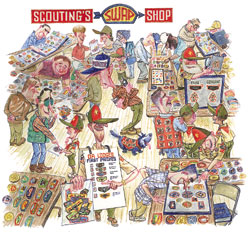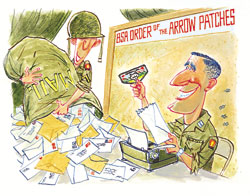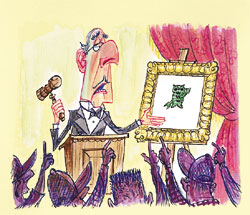![]() March-April 2001
March-April 2001
By Robert W. Peterson
Illustrations by Bill Basso

In various locations at every national Boy Scout jamboree, you'll see a line of blankets on the ground where collectors, young and old, are intensely involved in trading patches. They swap local council shoulder patches, Order of the Arrow lodge "flaps" (worn on the right shirt pocket by OA members), and patches from countless camporees and other special events.
Some collectors may also trade other types of memorabilia, like neckerchief slides, souvenir pins, and medallions. But most, whether savvy veterans with several years' experience or novices new to the game, are involved in a hobby that has been growing steadily for nearly 50 years—the collecting, trading, buying, and selling of Scouting patches and insignia.
Collecting Scout patches as a specialization is small potatoes compared with collecting postage stamps or sports cards. But Scouting devotees are just as dedicated as their counterparts in those more traditional specialties.
"It's a fascinating hobby," said Fred Lang Jr., a Scouting collector for 40 years. "It really gets into your blood."
Lang, an assistant Scoutmaster of Troop 174, chartered to Tilghman Angle Smith American Legion Post 851 in Dingmans Ferry, Pa., has organized an annual "trade-o-ree" for the past four years. The swap fest brings together serious traders from a wide area to display their collections and do some trading and, maybe, some buying and selling.
Scores of similar trade-o-rees are held across the country each year. They attract mostly devoted adult collectors, but Scouts and Scouters who enjoy viewing the colorful displays also attend. However, not many Scout-age hobbyists show their collections at trade-o-rees, because an exhibit table may cost $12 to $20 to rent and because automobile transportation is often needed to reach the location.
Most traders specialize in one or more of the 60-plus categories of collectibles recognized by the American Scouting Traders Association (ASTA), the largest of several collectors' groups.
The most popular specialty is almost certainly Order of the Arrow flaps—not a surprise given that an estimated 90 percent of ASTA's members are Arrowmen, according to ASTA president Craig Leighty of Pleasanton, Calif. "Probably 60 percent of them have OA patches as their main area of focus," he said.
ASTA has more than 1,300 members, nearly 20 percent of whom are Scout-age youths. But that's just the tip of the collecting iceberg.
"There are certainly thousands of youths—if not tens of thousands—who collect and trade at camporees and jamborees," Leighty said. Order of the Arrow events are also popular patch-swapping venues, he added. At a typical regional conclave of 8 or 10 OA lodges, for example, the 300 to 500 people attending could include from 40 to 100 boy and adult patch traders.
In second place for popularity after Order of the Arrow flaps are council shoulder patches (CSPs in patch-collecting lingo). The specialty has been growing ever since the BSA approved the use of colorful council patches in 1970. (Some traders also collect the red-and-white-lettered shoulder strips used to identify local councils before 1970.)
A local council might have a half-dozen CSPs in the field at the same time. Besides the standard CSP worn by 95 percent of boys and leaders, the council might sell a special CSP as part of its annual Friends of Scouting fund-raising campaign and issue others for council contingents bound for Philmont Scout Ranch in New Mexico and the biennial national Order of the Arrow conference (NOAC).
Speaking of NOAC, the granddaddy of all trade-o-rees is held in the host city just before the conference starts. Last July, the pre-NOAC 2000 trade-o-ree site was a Holiday Inn in Knoxville, Tenn., where memorabilia lovers could browse among more than 300 tables of patches and other displays. That made it about 10 times larger than the Poconos Trade-O-Ree sponsored by Fred Lang's troop the month before.
Gene Berman is a New York City dentist who has been a patch collector since 1967. Today, he has one of the most complete collections of OA lodge patches as well as a large number of first-issue council shoulder patches.
As a Scout in the 1950s, Berman saved all the badges he earned. But he did not consider trading any of them in order to expand the variety of his collection.
"There were not many varieties of [those kinds of patches] back then, so Scouts weren't trading to the extent they do today," he explained. "Most Scouts just saved Order of the Arrow and camporee patches."
Berman's serious interest in collecting developed while he was serving as a captain in the Army during the Vietnam War. He was assigned to set up a display on Scouting history for a group of soldiers from other nations who were being trained to fly U.S. helicopters.
 Organizing a display for the Army helped Gene Berman become a serious collector. |
"In those days, about all I could think of was OA patches, because there weren't that many other things to show," he recalled.
So he wrote to every one of the more than 500 local Scout councils then existing and asked for a sample OA flap. Some 300 councils sent patches.
Later, when he was stationed in Vietnam, Berman organized a second display of OA flaps, again for the benefit of soldiers from other countries. He wrote to the councils that hadn't responded to his first request—and added 125 more patches to his original 300.
By then, Berman was hooked on patch collecting, and his enthusiasm for the hobby continued to grow. Today, he attends a dozen trade-o-rees each year, in hopes of filling in the few gaps in his OA collection. And he was named the 10th winner of the George Boxer Memorial Award, ASTA's top honor for significant contributions to Scouting and to the collecting hobby. (The Boxer Award has been given each year since 1986 in memory of a Russian emigre who was a longtime Scouter and collector of memorabilia in the San Francisco Bay area.)
ASTA's strict code of ethics calls upon members to "apply the Scout Oath and Law in all trades and strive for fairness." Its members monitor trading at the pre-NOAC trade-o-ree to ensure that traders—especially younger Scouts—are not taken advantage of by unscrupulous collectors.
And during patch trading sessions at national Boy Scout jamborees, adults now are mandated to trade only with other adults, not with Scout-age collectors.
Ignorance of patch values can cause a novice trader—youth or adult—to unwittingly give away a high-value patch in exchange for something of far less value. And even if a Scout knows that a patch has high value, he may not realize he is being offered a fake version of the original.
At the Poconos Trade-O-Ree last June, Roy Wetherbee, a district committee member in the Mohegan Council, Worcester, Mass., displayed a collector's nightmare—fake patches designed to deceive. "Some rare OA flaps can be worth $7,000 to $10,000," he pointed out. "So somebody gets greedy [and decides to produces fake versions]—because he knows he can go overseas and have that patch copied for a dollar."
Fortunately, experts usually are not deceived by fakes, and word of their circulation gets out quickly in quarterly magazines and books on the hobby, Wetherbee said.
And it's impossible to make a perfect reproduction, he added. For one thing, many old patches were made of cotton and silk on traditional looms. Today, many patches are produced in places like Taiwan, using computers, synthetic thread, and a plastic back. "The classic materials are no longer available [and] the machinery is different, so they can never get it exact."
Not all reproductions are designed to exploit novice collectors. For example, a council might reproduce a classic badge to sell as a fund-raising item, pricing it far below what a collector would pay for the original.
But new collectors can easily be fooled by these legitimate reproductions, warned Art McHale, chairman of Troop 34's committee in Jessup, Pa. "If you don't know that the reproduction is worth only $5 and the original sells for $75, you might get ripped off," he said.
An example is the official patch from the BSA's first scheduled national Boy Scout jamboree in 1935. An original patch is listed in price guides for $150 or more, while an authentic-looking reproduction of the same patch can be had for about $5.
Serious traders think nothing of driving five hours or more to reach a trade-o-ree and indulge their fancy. At the Poconos Trade-O-Ree, Manny Bagaco and Steve Farrell, both leaders in the Moby Dick Council, New Bedford, Mass., took seven hours to reach Dingmans Ferry—and they considered it time well spent. Farrell is a novice collector, while Bagaco focuses on his specialty—memorabilia from the Maine National High Adventure Base, which closed 10 years ago as a national facility.
At the trade-o-ree, Bagaco was happy he could swap some of his patches from Order of the Arrow conclaves in New England. Although he didn't find anything to add to his specialty collection, he retained a collector's ever-optimistic outlook:
Maybe next time ...
Contributing editor Robert Peterson is the author of The Boy Scouts: An American Adventure. He lives in Ramsey, N.J.
How Much Is It Worth?Four factors determine the value of a patch, says Gene Berman, veteran collector of Order of the Arrow lodge patches. Two are obvious—supply and demand. The other two are not so obvious. One is what Berman calls "catalogability," meaning that the patch is pictured in one of the many books and reference works which establish its estimated monetary value. "Value, like beauty, is in the eye of the beholder," says Kirk H. Doan in his introduction to the 1988 edition of The Blue Book: A Guide to Council Shoulder Patch Varieties and Values. Reference books can provide only a "moderately educated opinion" of values, he points out, which mostly "should be used for comparison of relative values." It's difficult for traders to judge the value of patches issued each year for thousands of district camporees, because they are not cataloged, Berman says. But the same is no longer true for camp patches. "Since a book came out on camp patches, collecting them has increased [because of their] catalogability." The fourth factor in value involves hype and publicity. "Never underestimate their impact," Berman says. "If a patch appears in a magazine—and the collecting community knows that [only a] few of them were made—that patch becomes a more desirable acquisition." —R.W.P. |
Green Owl Patch Ranks as the 'Honus Wagner' of OA Insignia
Compared with the rarest postage stamps and baseball cards, the most prized Scouting memorabilia is dirt-cheap. For example, last year a 1909 trading card of Hall of Fame shortstop Honus Wagner sold for $1.1 million, while the highest recorded price paid for a piece of Scout memorabilia is $24,500. The latter figure was the winning bid at an auction several years ago for an Order of the Arrow patch issued about 1920 by Ranachqua Lodge No. 4 in the Bronx Council of the Greater New York Councils. The patch shows a green owl with the OA arrow behind it. Only one is known to exist, making it rarer than even the quartet of Wagner baseball cards still around. "It was one of the earliest OA patches, and there weren't a lot of OA insignia then, or even as late as the 1940s," collector Roy Wetherbee explained. Not all rare OA patches carry such a high price tag, and most are priced in the thousands of dollars. At the record-setting auction, however, a consortium of collectors from the East and West got into a bidding war and drove the price through the ceiling. —R.W.P. |
For More Information ...Sidebar content Neophyte collectors of patches and other Scouting memorabilia can learn more by checking the Web site of the American Scouting Traders Association at http://asta.scouter.org. Here are a few more of the many helpful Web sites and recent reference books dedicated to Scout patch collecting:
|
Copyright © 2001 by the Boy Scouts of America. All rights thereunder reserved; anything appearing in Scouting magazine or on its Web site may not be reprinted either wholly or in part without written permission. Because of freedom given authors, opinions may not reflect official concurrence.
| The Boy Scouts of America | http://www.scouting.org |